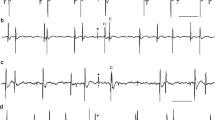Abstract
Motor unit (MU) potentials were recorded from the human rectus femoris and biceps brachii muscles during prolonged isometric contraction. Interspike intervals and intervals between adjacent discharges of 2 MUs (cross-intervals of MU pairs) were measured. Synchronization was expressed by the following criteria: the cross-interval histogram; comparison of the number of coincidences between discharges of 2 MUs observed experimentally with the mean probable number of coincidences; the frequency of appearance of N successive coincidences of spikes from different MU pairs; comparison of the mean duration of interspike intervals preceding a synchronized discharge with the mean duration of the remaining interspike intervals for the same MU. For some MU pairs the number of coinciding spikes was greater than the expected number of random coincidences. Synchronized spikes could form a train of consecutive coincidences. The mean duration of interspike intervals preceding a synchronized discharge was somewhat less than the mean duration of the remaining interspike intervals for MUs forming a synchronously firing pair.
Similar content being viewed by others
Literature cited
I. M. Gel'fand, V. S. Gurfinkel', Ya. M. Kots, M. L. Tsetlin, and M. L. Shik, "Synchronization of motor units and its experimental simulation," Biofizika,8, 475 (1963).
V. D. Gerasimov and I. D. Ponomareva, "Investigation of correlation between firing patterns of giant neurons in a center of the leech nervous system," in: Statistical Electrophysiology [in Russian], Vilnius (1968), pp. 129–140.
V. S. Gurfinkel', A. N. Ivanova, Ya. M. Kots, I. M. Pyatetskii-Shapiro, and M. L. Shik, "Quantitative characteristics of motor unit function under stationary conditions," Biofizika,9, 636 (1964).
E. K. Shukov and Yu. Z. Zakhar'yants, "Synchronous rhythms of action potentials during human muscular activity," Fiziol. Zh. SSSR,45, 1053 (1959).
G. P. Moore, D. G. Perkel, and J. P. Segundo, "Application of the theory of stochastic point processes for the detection and analysis of interaction between neurons," in: Models of Neuronal Structures [Russian translation], Moscow (1970), pp. 30–47.
R. S. Person, L. N. Volchek, V. P. Gundarov, and L. P. Kudian, "Investigation of synchronization between motoneuron discharges in man by cross-correlation analysis of interference electromyograms," Fiziol. Zh SSSR,53, 488 (1967).
R. S. Person and L. P. Kudina, "Investigation of the firing rate of human motoneurons during voluntary contraction of a muscle," Neirofiziologiya,3, 200 (1971).
R. S. Person and M. S. Libkind, "Simulation of interference bioelectrical activity," Biofizika,1, 127 (1967).
A. Fessard, "Mechanisms of interneuronal synchronization and their disturbance in epilepsy," in: Problems in General Neurophysiology and Higher Nervous Activity [in Russian], Moscow (1961), pp. 239–255.
V. E. Amassian, J. Macy, Jr., and H. J. Waller, "Patterns of activity of simultaneously recorded neurons in midbrain reticular formation," Ann. New York Acad. Sci.,89, 883 (1961).
B. Bigland and O. C. J. Lippold, "Motor unit activity in voluntary contraction of human muscles," J. Physiol. (London),125, 322 (1954).
F. Buchthal and A. Madsen, "Synchronous activity in normal and atrophic muscle," Electroenceph. Clin. Neurophysiol.,2, 425 (1950).
F. Buchthal and P. Pinelli, "Action potentials in muscular atrophy of neurogenic origin," Neurology,3, 591 (1953).
G. L. Gerstein and D. H. Perkel, "Simultaneously recorded trains of action potentials: analysis and functional interpretation," Science,164, 828 (1969).
F. Hertle and C. Hetzel, "Die Haufigkeit synchroner Entladungen motorischer Einkeiten im m. erector trunci des gesanden Menschen," Pflug. Arch. ges. Physiol.,273, 235 (1961).
O. Holmes and J. Houchin, "Units in cerebral cortex of the anaesthetized rat: the correlations between their discharges," J. Physiol. (London),187, 651 (1966).
J. Paillard, "Recherche sur la tendance a l'activite synchrone des unites motorices dans le muscle sain," Compt. Rend. Soc. Biol.,146, 853 (1952).
A. Taylor, "The significance of grouping of motor unit activity," J. Physiol. (London),162, 259 (1962).
Additional information
Institute of Problems of Information Transmission, Academy of Sciences of the USSR, Moscow. Translated from Neirofiziologiya, Vol. 4, No. 1, pp. 68–74, January–February, 1972.
Rights and permissions
About this article
Cite this article
Artem'eva, E.N. Correlation between discharges of human motor units during prolonged muscle contraction. Neurophysiology 4, 54–59 (1972). https://doi.org/10.1007/BF01067871
Received:
Issue Date:
DOI: https://doi.org/10.1007/BF01067871




